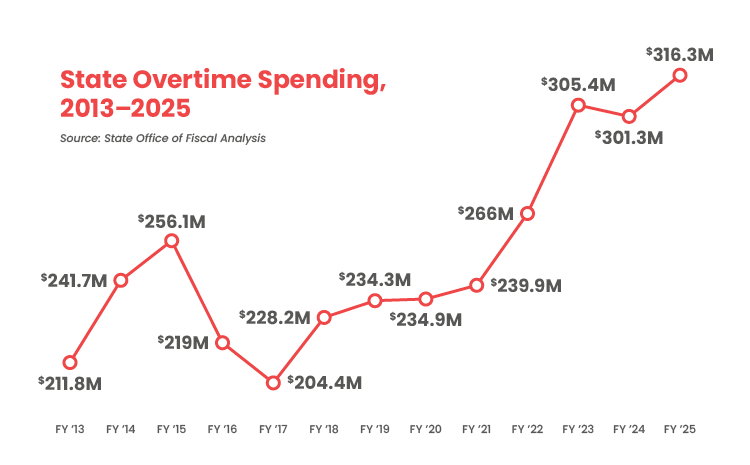State Overtime Spending Hits Record High

Connecticut state agencies paid out a record $316.3 million in employee overtime in fiscal 2025, $10.9 million (3.6%) more than the previous high set in 2023.
The state Office of Fiscal Analysis’ annual Agency Overtime Report shows that while 351 fewer employers collected overtime than in 2024, the average payout jumped 7.4% to $18,997.
Overtime spending—which has significant implications for taxpayers as it is among the factors used for calculating state employee pensions—increased $15 million (5%) over the previous fiscal year.
Failure to control costs places additional pressure on the state’s long-term liabilities burden, one of the highest per capita in the country.
Overtime costs hit a 10-year low in 2017, following passage of legislation requiring quarterly disclosures of agency spending.
However, spending has increased a staggering $111.9 million—55%—in the eight years since.
‘Double Jeopardy’
CBIA president and CEO Chris DiPentima called the failure to curb overtime costs “a disservice to taxpayers, who deserve better.”
“It’s double jeopardy—taxpayers pay now and then get hit again when soaring overtime costs drive up overall state employee retirement liabilities,” he said.
DiPentima said the issue highlighted a larger trend—based on the two-year budget adopted earlier this year, annual per capita state spending will reach $6,873 in 2027, twice the national average and 42% above 2009 levels.
“We’ve got an affordability crisis in Connecticut—particularly with energy, housing, and childcare—and that’s not going to get resolved if policymakers don’t curb state spending,” he said.

“Yet there are those in the legislature who want to dismantle the state’s critical fiscal guardrails, raise taxes, and continue to boost spending levels way above what other states spend.”
DiPentima acknowledged that while the labor shortage continues to impact state agencies and is a contributing factor in some instances, “outdated and inadequate workplace practices must be addressed.”
“Policymakers are sitting on a report that identified commonsense reforms that will generate between $70 million to $100 million in annual taxpayer savings,” he said.
“Those recommendations included capping pensionable overtime, modernizing workforce management, improving hiring processes, and strengthening overtime oversight and workers’ compensation practices.”
Overtime Spending: Top Five Agencies
| Department | FY 2025 Overtime | FY 2024 Overtime | $ Difference | % Difference |
|---|---|---|---|---|
| Correction | $118.8 million | $107.3 million | $11.5 million | 10.8% |
| Mental Health & Addiction Services | $62.9 million | $61.9 million | $982,053 | 1.6% |
| Emergency Services & Public Protection | $46.3 million | $43.7 million | $2.6 million | 5.9% |
| Developmental Services | $42.6 million | $42.7 million | ($148,988) | -0.3% |
| Children & Families | $30.3 million | $26.2 million | $4.1 million | 15.4% |
Source: State Office of Fiscal Analysis.
Fiscal 2025 costs increased $18.9 million (6.7%) over the previous year at the five state agencies responsible for more than 95% of all overtime spending.
The Department of Correction accounted for 38% of all agency overtime, spending $118.8 million, up $11.5 million (10.8%) over the previous year.
While the number of DOC employees paid overtime in fiscal 2025 declined by 169 (-3.4%), the average payout jumped 14.6% over the previous year to $24,624.
In calendar year 2024, 43 DOC employees were each paid more than $100,000 in overtime—one head nurse collected $207,110, bringing their total overtime pay since 2020 to $1.3 million.
DOC overtime spending has soared 48% in just the last eight years, despite the closure of three prisons and with the incarcerated population at a 35-year low, down 26% since 2017.
Understaffing, Outdated Procedures
Overtime at the Department of Mental Health and Addiction Services increased $982,053 (1.6%) in the fiscal year ending June 30 to $62.9 million.
In calendar 2024, 27 DMHAS employees were each paid at least $100,000 in overtime, including four workers who were paid more than $200,000.
The Department of Emergency Services and Public Protection saw a 5.9% increase to $46.3 million in fiscal 2025.
One hundred and seventy-two DESPP employees—primarily state troopers—were each paid over $100,000 in calendar 2024, including seven who collected more than $200,000.
While an audit cited chronic understaffing as a significant overtime factor, auditors also flagged outdated time and attendance procedures.
An audit released last month cited chronic understaffing as a significant factor driving DESPP overtime, although auditors also flagged inadequate recordkeeping and outdated time and attendance procedures.
“Failure to adequately monitor overtime costs and compliance with work and scheduling restrictions may have short-term impacts on the DESPP budget and long-term costs to the state,” the auditors noted.
Fiscal 2025 costs fell $148,988 to $42.6 million (-0.3%) at the Department of Department of Developmental Services, where 36 employees were paid over $100,000 in overtime in calendar 2024, including one who was paid $223,031.
Overtime spending rose 15.4% to $30.3 million at the Department of Children and Families. Six DCF employees were each paid over $100,000 on overtime in calendar 2024.
Other Agencies
Overtime spending at all other state agencies fell $3.9 million to $15.4 million (-20%) in fiscal 2025.
The Department of Social Services accounted for almost two-thirds of that decline, with agency costs falling $2.4 million to $5.1 million (-32.5%). That followed a $5.5 million drop the previous year.
Spending declined for a second year at the Connecticut Technical Education and Career System, falling $862,047 to $650,223 (-57%) .
Overtime spending at all other agencies fell 20%, with the Department of Social Services accounting for almost two-thirds of that decline.
Overtime costs fell $377,913 to $1.9 million (-16.3%) at the Judicial Department and declined $270,237 to $539,932 (-33.4%) at the Board of Regents
The Department of Energy and Environmental Protection spent $2.2 million, up 17.6% over last year, with overtime rising 7.5% to $2.2 million at the Department of Veterans Affairs.
DESPP employees collected an average $37,618—the highest of any agency—followed by DMHAS ($25,932), DOC ($24,624), DDS ($22,740), and the Office of Legislative Management, where 76 workers were paid an average $13,034.
RELATED
EXPLORE BY CATEGORY
Stay Connected with CBIA News Digests
The latest news and information delivered directly to your inbox.



